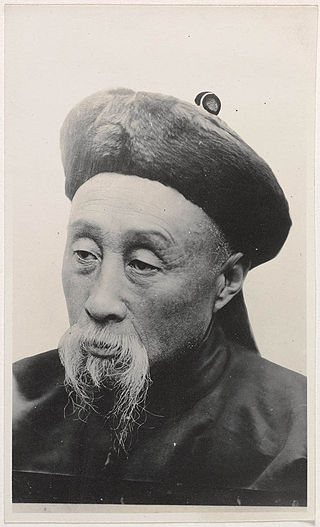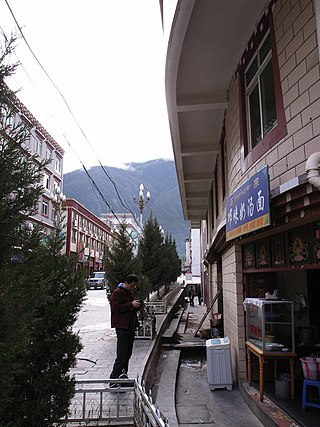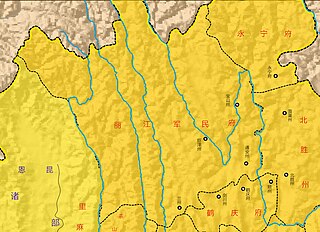
Kham is one of the three traditional Tibetan regions, the others being Domey also known as Amdo in the northeast, and Ü-Tsang in central Tibet. The official name of this Tibetan region/province is Dotoe. The original residents of Kham are called Khampas, and were governed locally by chieftains and monasteries. Kham covers a land area distributed in multiple province-level administrative divisions in present-day China, most of it in Tibet Autonomous Region and Sichuan, with smaller portions located within Qinghai and Yunnan.

The 7th Dalai Lama, Kelzang Gyatso, was recognized as the authentic 7th Dalai Lama of Tibet. He was seen as the true incarnation of the 6th Dalai Lama, and was enthroned after a pretender supported by foreign forces was deposed and arrested.

Litang County is southwest of Garzê Tibetan Autonomous Prefecture, in Sichuan, China, in the traditional Tibetan region of Kham. It contains 7 towns and a population of more than 60,000 in 2020. Due to its elevation and mountainous terrain, the county has an alpine climate. The Lithang Monastery has been the area's population center since the Chiefdom of Lithang. Several famous Tibetan Buddhist figures were born here, including the 7th Dalai Lama, the 10th Dalai Lama, the 11th Tai Situpa, four of the Pabalas, as well as the 5th Jamyang Zhépa of Labrang Monastery. Düsum Khyenpa, 1st Karmapa Lama, returned here and built Kampo Nénang Monastery and Pangphuk Monastery. It also has strong connections with the eponymous hero of the Epic of King Gesar.

Zhao Erfeng (1845–1911), courtesy name Jihe, was a late Qing Dynasty official and Han Chinese bannerman who belonged to the Plain Blue Banner. He was an assistant amban in Tibet at Chamdo in Kham. He was appointed in March, 1908 under Lien Yu, the main amban in Lhasa. Formerly Director-General of the Sichuan-Hubei Railway and acting viceroy of Sichuan province, Zhao was a much-maligned Chinese general of the late imperial era who led military campaigns throughout Kham, earning himself the nickname "the Butcher of Kham" and "Zhao the Butcher".

Tusi, often translated as "headmen" or "chieftains", were hereditary tribal leaders recognized as imperial officials by the Yuan, Ming, and Qing dynasties of China, and the Later Lê and Nguyễn dynasties of Vietnam. They ruled certain ethnic minorities in central China, western China, southwestern China, and the Indochinese peninsula nominally on behalf of the central government. As succession to the Tusi position was hereditary, these regimes effectively formed numerous autonomous petty dynasties under the suzerainty of the central court. This arrangement is known as the Tusi System or the Native Chieftain System. It should not be confused with the Chinese tributary system or the Jimi system.

Batang Town, officially Xiaqiong Town, is a town in Batang County, Garzê Tibetan Autonomous Prefecture, Sichuan Province, in the China on the main route between Chengdu and Lhasa, Tibet, and just east of the Jinsha River, or Upper Yangtze River. It is at an elevation of 2,700 metres.

Gaocheng Town, also known as Litang, is the administrative centre of Litang County in the southwest of the Garzê Tibetan Autonomous Prefecture in Sichuan Province of China.

Batang County is a county located in western Garzê Tibetan Autonomous Prefecture, Sichuan Province, China. The main administrative centre is known as Batang Town.
The Batang uprising was an uprising by the Khampas of Kham against the assertion of authority by Qing China.
In 1910, Qing China sent a military force of 2,000 troops to Tibet, then a Qing protectorate, ostensibly to assert imperial authority. It led to turmoil in Tibet and caused the Dalai Lama to flee to British India. It also caused a serious rupture in Sino-Tibetan relations that eventually led to Tibet's declaration of independence in 1912.

The Chiefdom of Lijiang was a Nakhi autonomous Tusi chiefdom that ruled Lijiang during Yuan, Ming and Qing dynasty.

Tibet under Qing rule refers to the Qing dynasty's rule over Tibet from 1720 to 1912. The Qing rulers incorporated Tibet into the empire along with other Inner Asia territories, although the actual extent of the Qing dynasty's control over Tibet during this period has been the subject of political debate. The Qing called Tibet a fanbu, fanbang or fanshu, which has usually been translated as "vassal", "vassal state", or "borderlands", along with areas like Xinjiang and Mongolia. Like the preceding Yuan dynasty, the Manchus of the Qing dynasty exerted military and administrative control over Tibet, while granting it a degree of political autonomy.

The Chiefdom of Bozhou, ruled by the Yang clan, was an autonomous Tusi chiefdom established by Yang Duan (楊端) during the Tang dynasty. After he conquered the Bozhou Prefecture from the Nanzhao Kingdom, Yang Duan was recognized as the hereditary ruler of the region by the Tang court in 876.

Kingdom of Chakla or Chala was a kingdom in the Tibetan region of Kham.
Gonpo Namgyal (1799–1865), also known as Bulungwa or 'Blind Warrior of Nyarong), was a Tibetan rebel leader from the Nyarong valley who unified the region, then most of Kham in a series of military campaigns from the late 1830s to the mid-1860s, warring also against Qing Dynasty forces and later the Tibetan government in Lhasa's Ganden Phodrang forces. While he was successful in defeating Qing forces, he was eventually captured and killed by Tibetan forces, putting an end to his rebel state in Nyarong and to Qing presence in Kham.
Chiefdom of Chuchen, also known as Rabden or the Chiefdom of Greater Jinchuan, was an autonomous Gyalrong Tusi chiefdom that ruled Greater Jinchuan during the Qing dynasty. The rulers of Chuchen used the royal title Namkha Gyalpo, literally "king of Namkha".
Chiefdom of Tsanlha, also known as Chiefdom of Lesser Jinchuan, was an autonomous Gyalrong chiefdom that ruled Lesser Jinchuan during Qing dynasty. The rulers of Tsanlha used the royal title Tsanlha Gyalpo.
Chiefdom of Bathang, or Chiefdom of Batang, was an autonomous Tusi chiefdom that ruled Bathang during the Qing dynasty period.
Chiefdom of Yongning was a Mosuo autonomous Tusi chiefdom during the Ming and Qing dynasties. The chiefdom was located at present-day Ninglang Yi Autonomous County at the convergence of Yunnan, Sichuan and Tibet.
The Gyalrong, also called the rGyalrong or Jiarong, are speakers of the Qiangic Gyalrong language who live in the southern part of Ngawa Tibetan and Qiang Autonomous Prefecture of Sichuan, China. They are also found in Danba County of Garze Prefecture. The word Gyalrong is an exo-ethnonym and loanword from the Tibetan word rGyal-mo tsha-wa rong.











